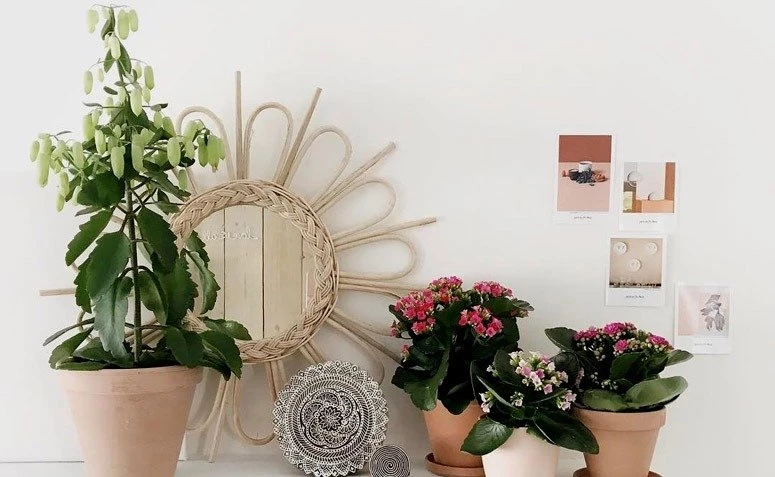Table of contents

Kalanchoe is a genus of succulent plants of African origin. They are plants with a rustic appearance, fleshy leaves, and flowers in various colors. It is an easy-to-grow plant, with durable beauty, that can be planted in the garden or in pots to decorate the house.
To find out more about the diversity of the kalanchoe, see below about its special meaning, learn about its different species, and check out the care for growing this lovely plant:
Meaning of kalanchoe
The kalanchoe is also known as the fortune flower and has a special meaning for gifting friends and family, as it is considered a plant that brings joy and prosperity. In addition, it is seen as a sign of friendship and a symbol of gratitude.
For you who are looking for a remarkable way to show your affection, this flower can be the ideal choice as a gift for a loved one.
Types of kalanchoe
The genus kalanchoe is composed of different types of plants. Learn more about some of them and see their main characteristics:
- Kalanchoe blossfeldiana: This species has an abundant bloom that presents itself in small groups and is ideal for decorating the environments of the house. It has several shades that vary between red, pink, orange, yellow, and white.
- Kalanchoe daigremontiana: known as mother-of-thousands, this plant has a high propagation capacity with the production of shoots along the edge of its leaves. It has narrow, pointed, serrated leaves that vary from green to gray with purple spots on the underside.
- Kalanchoe fedtschenkoi: Also known as kalanchoe-fantasma, its main characteristic is its grayish color with pink margins. Its flowers are pendent and fall in a lustre shape.
- Kalanchoe tomentosa: This plant attracts attention by the color and texture of its leaves. It is popularly known as cat-ear because of its silvery-gray appearance covered by short white hairs with brown dots at the edges.
- Kalanchoe pumila: is a very ornamental type, with oval leaves in a silvery-gray color with light hints of pink. It has thin stems with 4-petaled pink, curved flowers.
- Kalanchoe laetivirens: This species has large leaves with an elongated shape and curved sides. It is also known as mother-of-thousands because of its large production of seedlings at the edge of its leaves.
- Kalanchoe beharensis: is a shrubby type, growing up to 2 m tall. It has a thin, long stem with triangular-shaped, velvety leaves with jagged, wrinkled edges.
- Kalanchoe pinnata: is a small shrub that has oval-shaped leaves with serrated edges and pinkish tubular flowers. It is also known as the fortune leaf and has medicinal properties.
- Kalanchoe luciae: This type is distinguished by the shape and exuberant color of the leaves. Its color varies according to the temperature of the environment and the level of sunlight, and can be light green, bluish, or yellowish with reddish edges.
The kalanchoe genus stands out with its great variety of plant types. Each one has a unique beauty and ornamental characteristics that are perfect for the most different types of cultivation.
How to grow kalanchoe
Now that you know a little about the most common types, learn with the following videos tips on how to grow, care, and reproduce the plant:
Amazing tips for growing in a pot
The kalanchoe draws attention with its beautiful flowers, but it takes some care to keep it beautiful and blooming.
See_also: Armless sofa: optimize your space with 60 cozy modelsHow to grow kalanchoe
This other video also has a lot of information about growing kalanchoe and is a good way to complement your knowledge about this plant.
How to grow kalanchoe
The video brings a practical tutorial for planting your seedling and also teaches how to make a substrate preparation for cultivation. Learn how to make a simple, but effective mixture to keep your plants beautiful and vigorous.
See_also: Kitchen Curtain: 50 amazing designs to inspire youHow to make stem and leaf cuttings
Here's how to make kalanchoe seedlings with pieces of the stem or leaf. The process is very simple, quick, and easy to do.
How to take care of prunings and seedlings
Here you can find tips on how to care for kalanchoe, with instructions on how to prune the dried flowers and strengthening them. You can then use the removed branches and leaves to make new seedlings.
How to plant and reproduce seedlings
Learn how to plant the plant and how to reproduce it step by step, find out how to make the kalanchoe bloom with the use of fertilizer, learn more about its cultivation, and watch a suggestion on how to make the plant even more beautiful to give as a gift.
Whether you've won or purchased a specimen, the kalanchoe is a long-lasting, easy-to-grow plant that requires simple care to maintain its beauty. Remember to place it in a location that receives sunlight for a few hours a day and water only when the soil is dry.
With all this information, you will get beautiful and showy specimens to color your garden or delicately decorate your home.


